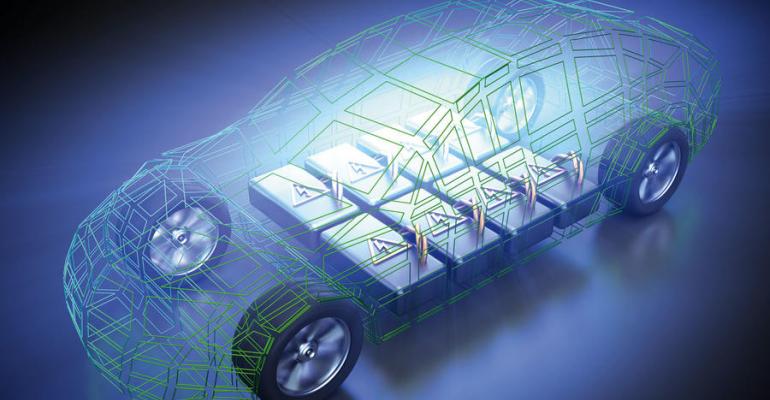The electric vehicle continues to grow as a mode of transportation.
By 2030, the International Energy Agency estimates there could be 200 million battery or plug-in hybrid electric light-duty vehicles globally. Add to that the heavy-duty electric vehicles coming online this decade, and it is clear we have entered a new era.
EV battery packs do not last forever, and their component parts will be at a premium. That begs the question: how to manage used battery packs that reach their end-of-life. Handling, transportation, recycling and stewardship of used EV batteries implicates waste management, raw materials conservation and global economics.
The still-evolving regulatory landscape governing these issues in the U.S. and the European Union will be critically important to vehicle and battery manufacturers, fleet owners and battery recyclers.
Currently, U.S. federal law does not mandate EV battery recycling or compel battery producers or EV manufacturers to “take back” batteries at the end of their useful life. Instead, federal laws generally streamline requirements for handlers, transporters and destination facilities that dispose of or recycle battery packs.
Without a federal mandate, states have begun exploring EV battery recycling or reuse laws. California, for example, created in 2018 a Lithium-Ion Car Battery Recycling Advisory Group to provide policy recommendations to the legislature, which are expected in April 2022.
The federal-level EV battery initiatives to date are focused on R&D grants to stimulate private industry. The U.S. Department of Energy, for example, has a Battery Recycling Prize competition to fund entrepreneurs developing lithium-ion battery recycling technologies to address not only EVs but also consumer electronics and industrial applications.
 As part of its climate agenda, the Biden Admin. is supporting domestic EV deployment, including proposing to convert the entire federal fleet. Congress may also soon develop nationwide rules to require recycling quotas or takeback requirements. A bill was recently introduced that would create a task force to make recommendations for how to design systems to improve battery lifecycle management.
As part of its climate agenda, the Biden Admin. is supporting domestic EV deployment, including proposing to convert the entire federal fleet. Congress may also soon develop nationwide rules to require recycling quotas or takeback requirements. A bill was recently introduced that would create a task force to make recommendations for how to design systems to improve battery lifecycle management.
The U.S. end-of-life EV battery regime stands in sharp contrast to that in the EU.
EU rules on management of end-of-life batteries are set out in the Batteries Directive, which sets out specific takeback and recycling requirements for industrial batteries used in EVs. First, battery producers or third parties acting on their behalf must take back waste batteries from end-users. Second, all collected batteries must be recycled. Third, recycling processes must achieve specific minimum recycling efficiencies.
As part of its wider European Green Deal, the EU recently proposed an enhanced Batteries Regulation, which would establish a competitive, circular and sustainable value chain for all batteries in the EU. If adopted, producers will be required to (i) organize and finance the collection, treatment and recycling of waste batteries, and (ii) take back any waste batteries free of charge, without requiring end-users to buy a new battery or to have bought the battery from them.
 All collected batteries must be recycled, subject to minimum recycling efficiency targets and minimum material recovery targets for cobalt, copper, nickel, lead and lithium. By 2030, batteries sold in the EU will have to meet minimum recycled content targets for cobalt, lead, lithium and nickel.
All collected batteries must be recycled, subject to minimum recycling efficiency targets and minimum material recovery targets for cobalt, copper, nickel, lead and lithium. By 2030, batteries sold in the EU will have to meet minimum recycled content targets for cobalt, lead, lithium and nickel.
Practice Pointers
- Industry often outpaces regulators. New battery technologies, such as lithium-ion EV batteries or the breakthrough solid-state EV batteries of the future, likely will be developed before regulators formulate policy to govern them. This means the technology may exist in a regulatory gray area for a time or new technologies may be clumsily pigeonholed into old regulatory frameworks.
- In the U.S., know your state. Individual states are expected to act faster than federal regulators on EV battery stewardship. Always know the requirements in the individual jurisdictions where you operate or sell. Sometimes this means defaulting to the most stringent state requirements.
- In the EU, keep a close eye on new innovative rules in the pipeline, which may affect the entire EV battery value chain. If you sell EV batteries in the EU, be prepared to meet minimum recycled content and responsibility for take-back and efficient recycling of waste batteries.

Sam Boxerman (pictured above, left) is a partner in Sidley Austin LLP’s Washington, DC, office and a member of the firm’s Environmental practice group. Sven De Knop (left) is a partner in Sidley’s Brussels office and a member of the firm’s Global Arbitration, Trade and Advocacy practice group. Also contributing to this article were Dominic Coppens and Maryanne Kamau, both from Sidley’s Brussels office, and Joseph Zaleski, from the Washington, DC, office.





